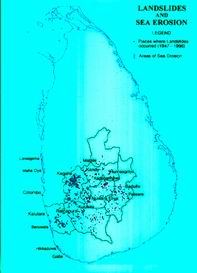 |
Vol. 8, No. 4 October-December 2002
|
Disaster Reduction in Mountainous Areas in Sri Lanka: Failures and Successes With the opening up of its economy in the mid-1980s, Sri Lanka saw rapid development and growth, especially in the hill regions. It was also during this period that the country witnessed an escalation in landslide disasters and therefore the two events have been linked. To cite an example, in 1986 following unprecedented rain, more than 51 lives were lost, 10,000 families were rendered homeless and most development plans in the troubled areas came to a grinding halt. Even before the country could recover from the aftermath of these catastrophic events, landslides struck several parts of the island with even greater fury again in 1989. Over 300 people were killed and more than 15,000 families became homeless. A UNDP assessment team placed the direct losses at US$ 35.5 million. The extent of indirect losses will perhaps never be known. Even in 1993, 1994, 1998 and 1999, landslides were responsible for heavy losses and this is continuing.
The National Building Research Organization estimates that landslide and rain-induced mass movement in Sri Lanka cause an average of 10 to 15 deaths (NBRO, 1999), not taking into account government social welfare packages for victims. According to investigations carried out to date, seven hill districts of Sri Lanka (Badulla, Nuwara Eliya, Kegalle, Ratnapura, Kandy, Matale and Kalutara) are subject to such disasters. The districts of Badulla and Ratnapura are the most hard hit. Of Sri Lanka’s 65,000 sq km area, nearly 12,000 sq km (21%) are highly prone to landslides. Urbanization is blamed for this increase in landslide frequency. The failure to reduce the problem is primarily attributed to the ever-increasing pressure of development in areas of geologically hazardous terrain and the failure of responsible government entities and private developers to recognize the impact of such hazards and to apply appropriate measures for their mitigation, even though there is overwhelming evidence that hazard mitigation programs serve both public and private interests by saving many times the cost of implementation. Unlike cyclone hazards, landslides cannot be predicted accurately. They are triggered mainly by an increase in sub-surface pore water pressure formations, in many cases resulting from heavy rainfall. In the case of this year’s Puwakgahawela landslide disaster, symptoms had been noticed in the late 1990s and warnings were issued to residents. Since landslides had not occurred for a long time in this area, people had forgotten that the area was vulnerable. When warnings were issued, the community did not take it seriously. When the dormant landslide came alive, farming communities were taken by surprise. Though resettling the population to safer areas is an appropriate solution, it cannot be implemented because of issues of finding arable land for cultivation, reluctance of communities to leave traditional ancestral land, and shortage of land itself due to increasing population. NBRO has been active in providing information on the symptoms of landslides. They have formed vigilance groups to patrol vulnerable areas but with limited success. They carry out school programs and have developed a series of school books to create interest by children on landslide management. Community residents are the first to notice symptoms and usually inform the local police or the divisional secretariat about the impending disaster. This has helped in taking quick responsive actions which have saved lives. NBRO also has developed construction guidelines for local government authorities in hilly areas of Sri Lanka. The authorities recognize the importance of these guidelines and land use planning and recommend obtaining clearance certificates from a competent authority before undertaking any development work in known landslide areas. Environmental Impact Assessments (EIA) are required for major development projects, and have to recognize the impact of natural hazards like landslides. Landslide Mitigation Programs and Initiatives In 1990 the Government of Sri Lanka sought UNDP/UNCHS assistance which culminated in the implementation of the pilot “Landslide Hazard Mapping Project”. Consequently, several projects and programs were conducted by the Sri Lanka Government to reduce disaster vulnerability with the help of other organizations and foreign agencies, placing greater emphasis on cost effective, pre-disaster mitigation and prevention measures than on expensive post-disaster processes. Projects such as the Landslide Hazard Zonation Mapping Project (LHMP) and Sri Lanka Urban Multi-Hazard Disaster Mitigation Project (SLUMDMP) have sought to mitigate landslide disasters through hazard zonation mapping; introduction of standards, guidelines and codes of practice for human settlement planning and site selection in hilly areas; awareness campaigns for design planners and villagers (including craftsmen living in landslide-prone areas); training of staff on the implementation of various guidelines; and institutionalization of natural disaster mitigation processes, appropriate technology and information dissemination. NBRO, the Centre for Housing Planning and Building (CHPB) and the Urban Development Authority (UDA) are active players in the implementation of these mitigation projects and have jointly collaborated in hazard and vulnerability mapping, risk analysis, strategic planning, periodic review of policy and procedures, training and professional development, and networking. Some successes are the development of Disaster Mitigation Action Plans for the Ratnapura Municipal Council and the Nawalapitiya Urban Council Emergency Management and Response (Alert) Plans. The two councils have since taken action to implement these plans. This initiative is expected to be replicated in other landslide-prone districts. SLUMDMP is nearing completion, but the Landslide Hazard Zonation Mapping Project is being continued by NBRO through 2007. A comprehensive and effective national strategy for reducing losses from landslides, including activities at national, provincial, local, community and household levels is the call of the day. R M S Bandara is Assistant Project Manager, SLUMDMP and Head, Landslide Studies and Services, NBRO, Sri Lanka, and N M S I Arambepola is Deputy Program Manager with the Asian Urban Disaster Mitigation Program, ADPC. They can be contacted at nbro@sltnet.lk and arambepola@ait.ac.th |

